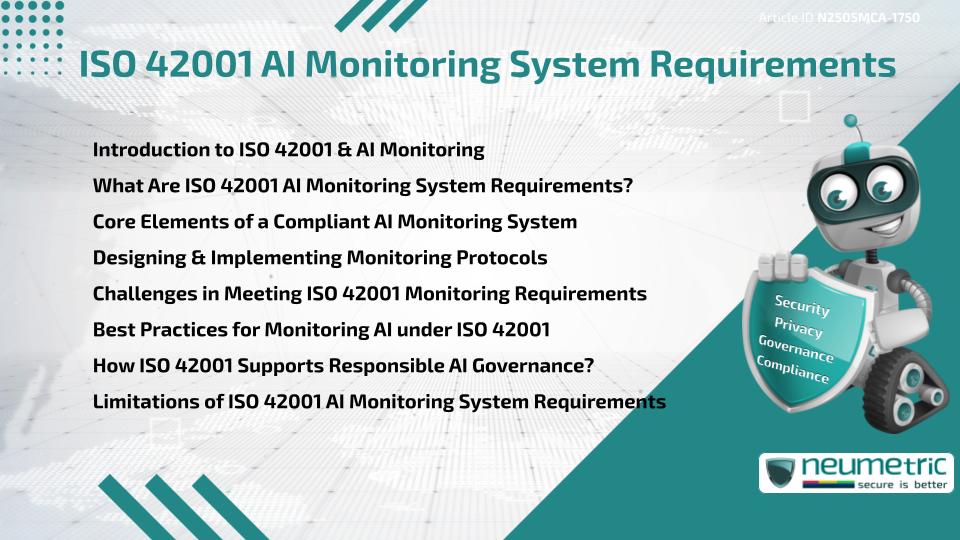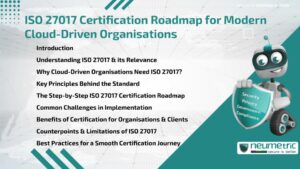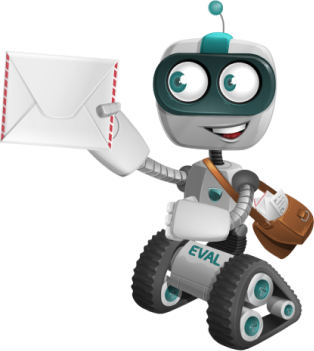Table of Contents
ToggleIntroduction to ISO 42001 & AI Monitoring
As Artificial Intelligence [AI] becomes more integrated into critical decision-making processes, concerns about its reliability, fairness & transparency continue to grow. To address these challenges, the International Organisation for Standardisation [ISO] introduced ISO 42001, a Standard focused on managing AI Systems responsibly. One of the most vital parts of this Standard is the ISO 42001 AI monitoring system requirements, which outline how Organisations should oversee AI System performance & ethical Compliance.
Monitoring is not just a technical requirement. Monitoring AI under ISO 42001 is a moral necessity, helping ensure that these systems operate in line with both societal values & business objectives. By meeting the ISO 42001 AI monitoring system requirements, companies can reduce Risks, improve accountability & build Stakeholder trust.
What Are ISO 42001 AI Monitoring System Requirements?
The ISO 42001 AI monitoring system requirements are a set of defined expectations that guide how AI activities must be observed, assessed & corrected. These requirements ensure that AI Systems operate within expected parameters & remain consistent with declared objectives.
According to the ISO official documentation, monitoring systems must include mechanisms for:
- Recording operational behaviour
- Detecting anomalies
- Identifying unintended outcomes
- Providing alerts for Corrective Actions
In essence, the goal is to create a loop of continuous oversight where issues are not only detected but also addressed in real time.
Core Elements of a Compliant AI Monitoring System
Meeting the ISO 42001 AI monitoring system requirements means implementing several key components. These include:
- Defined Metrics: Establishing what to monitor, such as accuracy, fairness or drift in model behaviour.
- Data Logging: Keeping records of system actions & inputs for traceability.
- Alert Mechanisms: Automatic triggers that notify Stakeholders when a deviation occurs.
- Response Protocols: Step-by-step processes for handling detected issues.
Each of these elements supports traceability, accountability & Compliance with ethical & operational norms. Without them, Organisations Risk deploying opaque & potentially harmful AI Systems.
Designing & Implementing Monitoring Protocols
Creating a compliant monitoring protocol involves both technical architecture & Governance planning. Teams must consider the types of AI Models used, the environments in which they operate & the Stakeholders impacted by the outcomes.
An effective implementation strategy might include:
- Periodic Audits of model outputs
- Performance benchmarking
- Real-time dashboards for operations
- Stakeholder Feedback Loops
Challenges in Meeting ISO 42001 Monitoring Requirements
While the intent of the ISO 42001 AI monitoring system requirements is clear, implementation can be challenging. Common issues include:
- Limited transparency: Black-box models make monitoring difficult.
- Data Privacy concerns: Monitoring could conflict with Data Protection regulations.
- Lack of skilled personnel: AI oversight demands cross-functional expertise.
These hurdles make it essential for Organisations to adopt flexible, context-specific monitoring frameworks. For example, high-Risk use cases may demand stronger human oversight, while low-Risk tasks might allow for automated checks.
Best Practices for Monitoring AI under ISO 42001
Organisations looking to align with ISO 42001 AI monitoring system requirements can benefit from adopting the following Best Practices:
- Use Explainable AI [XAI]: Ensure that decisions can be understood by humans.
- Apply Risk-Based Monitoring: Focus resources on high-impact areas.
- Maintain Role Clarity: Assign specific responsibilities for AI oversight.
- Review Regularly: Update monitoring plans as technology & use cases evolve.
These practices improve system accountability & reduce the Likelihood of ethical or operational failures.
How ISO 42001 Supports Responsible AI Governance?
One of the biggest advantages of adhering to ISO 42001 AI monitoring system requirements is that it enables responsible AI Governance. By providing structured guidance, it ensures:
- Human oversight: Especially in sensitive or high-Risk applications
- Regulatory alignment: Supporting Compliance with global rules like the EU AI Act
- Operational consistency: Reducing the Likelihood of failure in live environments
ISO 42001 thus acts as both a technical guide & a Governance tool, helping companies navigate the complex landscape of AI deployment responsibly.
Limitations of ISO 42001 AI Monitoring System Requirements
Despite its value, ISO 42001 is not without limitations. These include:
- Lack of industry-specific guidance: Requirements are generic & not tailored to sectors like Finance or Healthcare.
- No enforcement mechanism: ISO Compliance is voluntary & self-declared
- Possible over-reliance on automation: Excessive trust in AI tools can still lead to failures if human oversight is lacking.
Understanding these limitations helps Organisations apply ISO 42001 with the right balance of structure & flexibility.
Takeaways
- ISO 42001 provides a clear & organised framework to help organisations monitor their AI systems responsibly.
- Effective monitoring includes defined metrics, alert systems & response protocols.
- Practical implementation requires both technical tools & Governance strategies.
- Following Best Practices & acknowledging limitations enhances overall AI System reliability.
FAQ
What is the main purpose of ISO 42001 AI monitoring system requirements?
The main purpose is to ensure that AI Systems are continuously observed & evaluated to detect anomalies, prevent harm & support ethical AI use.
Do ISO 42001 AI monitoring system requirements apply to all types of AI?
Yes, the requirements are broadly applicable but need to be adapted depending on the system’s complexity, use case & impact.
How does ISO 42001 differ from other AI Governance Standards?
ISO 42001 provides a management system approach, focusing on operational controls like monitoring, unlike some standards that focus only on ethical principles.
Can Small Businesses implement ISO 42001 AI monitoring system requirements?
Yes, but they may need simplified frameworks. The flexibility of ISO 42001 allows tailoring based on organisational capacity & Risk profile.
Are manual reviews still needed under ISO 42001 AI monitoring system requirements?
Yes, human oversight remains a critical part of the standard, especially in high-Risk scenarios where decisions must be explainable.
What common challenges do Organisations face while implementing ISO 42001 monitoring?
Challenges include technical complexity, Data Privacy concerns & lack of internal expertise in monitoring systems.
Is ISO 42001 mandatory for AI Compliance?
No, it is voluntary but widely recognised as a best-practice Standard for responsible AI Management.
How can Organisations start aligning with ISO 42001?
They can begin by conducting an AI Risk Assessment, defining monitoring objectives & selecting appropriate tools & teams for oversight.
Need help?
Neumetric provides organisations the necessary help to achieve their Cybersecurity, Compliance, Governance, Privacy, Certifications & Pentesting goals.
Organisations & Businesses, specifically those which provide SaaS & AI Solutions, usually need a Cybersecurity Partner for meeting & maintaining the ongoing Security & Privacy needs & requirements of their Clients & Customers.
SOC 2, ISO 27001, ISO 42001, NIST, HIPAA, HECVAT, EU GDPR are some of the Frameworks that are served by Fusion – a centralised, automated, AI-enabled SaaS Solution created & managed by Neumetric.
Reach out to us!





